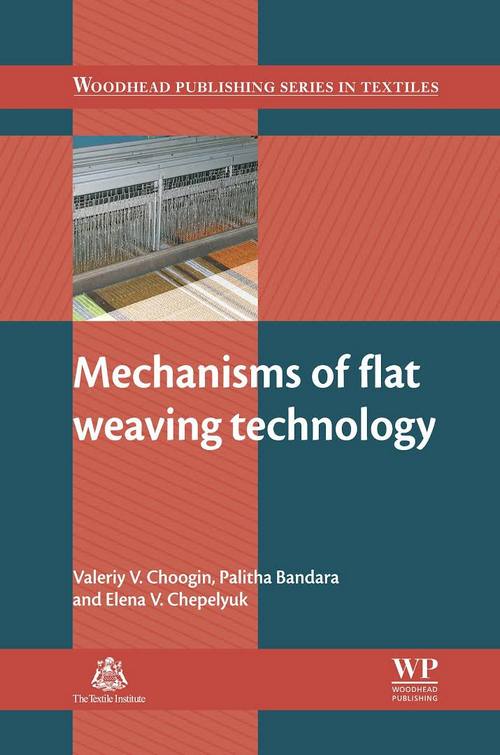
Contents
Woodhead Publishing Series in Textiles ix
Preface xv
Note for students using this book xix
1 Introduction: classification and mechanisms of weaving machines 1
1.1 Introduction 1
1.2 Classification of weaving machines 2
1.3 Basic mechanisms of the weaving machine 4
1.4 Elastic system of fabric formation (ESFF) 5
1.5 Advantages and disadvantages of different weaving machines 15
1.6 Questions for self-assessment 15
1.7 References 16
2 Mechanisms of the weaving machine for warp release and warp tension control 17
2.1 Introduction: mechanisms of the weaving machine for warp release and warp tension control 17
2.2 Warp brakes 20
2.3 Warp regulators 24
2.4 Condition of the equilibrium of the mechanism of a moving back-rest 34
2.5 Stabilization of the mode of release and the tensioning of warp threads 35
2.6 Comparative analysis of brakes and regulators 36
2.7 Questions for self-assessment 37
2.8 References 39
3 Warp shedding in weaving: parameters and devices 40
3.1 Introduction: parameters of the shed 40
3.2 Elongation of warp threads in shedding 44
3.3 The classifi cation of shedding devices 49
3.4 Tappet shedding 49
3.5 Dobbies 54
3.6 The Jacquard machine 58
3.7 Comparative analysis of shedding devices 61
3.8 Questions for self-assessment 62
3.9 References 63
4 The supply of weft on the weaving machine 64
4.1 Introduction: the supply of weft on the weaving machine 64
4.2 Gauges for detecting the presence of weft on shuttle weaving machines 65
4.3 Battery type weft supply 67
4.4 Mechanisms for changing pirns 69
4.5 Safety devices of automatic pirn change 71
4.6 Change of hollow pirns 71
4.7 Change of shuttles 72
4.8 Multishuttle mechanisms 72
4.9 Weft supply on shuttleless weaving machines 76
4.10 Devices for measuring and control of weft tension 78
4.11 Questions for self-assessment 81
4.12 References 82
5 Weft insertion 83
5.1 Introduction: methods of weft insertion 83
5.2 Continuous insertion of weft by shuttle 88
5.3 Weft insertion by microshuttle 89
5.4 Weft insertion by projectile 92
5.5 Weft insertion by rapiers 95
5.6 Weft insertion by air and water jets 100
5.7 Pneumatic-rapier weft insertion 103
5.8 Weft insertion by an electromagnetic drive 106
5.9 Weft insertion by the inertial method 106
5.10 Comparative analysis of different methods of weft insertion 106
5.11 Questions for self-assessment 107
5.12 References 108
6 Woven fabric formation: principles and methods 109
6.1 Introduction: woven fabric formation 109
6.2 Fabric-forming mechanisms 112
6.3 Formation of the woven fabric cell 114
6.4 Parameters of woven fabric formation 116
6.5 Ring temples 121
6.6 Methods of easing of fabric formation 122
6.7 Comparative analysis of the methods of fabric forming 123
6.8 Questions for self-assessment 123
6.9 References 124
7 Mechanisms for woven fabric take-up 125
7.1 Introduction: mechanisms for woven fabric take-up 125
7.2 Winding woven fabric on the cloth beam 131
7.3 Comparative analysis of methods of woven fabric take-up 132
7.4 Questions for self-assessment 133
7.5 References 134
8 Safety devices on weaving machines 135
8.1 Introduction: safety devices on weaving machines 135
8.2 Weft controllers 137
8.3 Devices for prevention of warp thread breakage 142
8.4 Comparative analysis of safety devices 144
8.5 Questions for self-assessment 144
8.6 References 144
9 Weaving machine drives: mechanisms and types 145
9.1 Introduction: the weaving machine drive 145
9.2 Mechanisms for driving the main shaft of a weaving machine 146
9.3 Weaving machine brakes 148
9.4 Combined start-up and braking mechanisms 149
9.5 Comparative analysis of different loom drives 149
9.6 Questions for self-assessment 150
9.7 References 150
10 Weaving machine parameters for specifi c woven fabric structures 151
10.1 Introduction: the normalization process for weaving operations 151
10.2 Estimating drawing-in parameters for a weaving machine 153
10.3 Setting up parameters for the machine–yarn–fabric path
(MYFP) on weaving machines 155
10.4 Verifi cation of parameters for the elastic system of fabric formation (ESFF) and machine–yarn–fabric path (MYFP) on weaving machines 156
10.5 Evaluating warp thread tension by oscillogram analysis 157
10.6 Coordination of weaving cycles 165
10.7 Factors affecting the productivity of weaving machines 166
10.8 Comparing operating conditions for natural and synthetic fibres 168
10.9 Questions for self-assessment 169
10.10 References 170
11 Control of woven fabric quality: defects and quality assurance of grey fabrics 171
11.1 Introduction: the quality control of woven fabric 171
11.2 Defects in grey fabric 172
11.3 Quality assurance of grey fabric 174
11.4 Equipment for the control of woven fabric quality 175
11.5 Questions for self-assessment 177
11.6 References 178
12 Movement of raw materials and fi nished fabrics in weaving manufacture 179
12.1 Introduction: product transportation in weaving manufacture 179
12.2 Transportation of raw materials and outputs 179
12.3 Questions for self-assessment 181
12.4 References 181
Appendix 1: Further reading on weaving technology 183
Appendix 2: Glossary of terms applied to weaving machines
and weaving technology 185
Index 205
